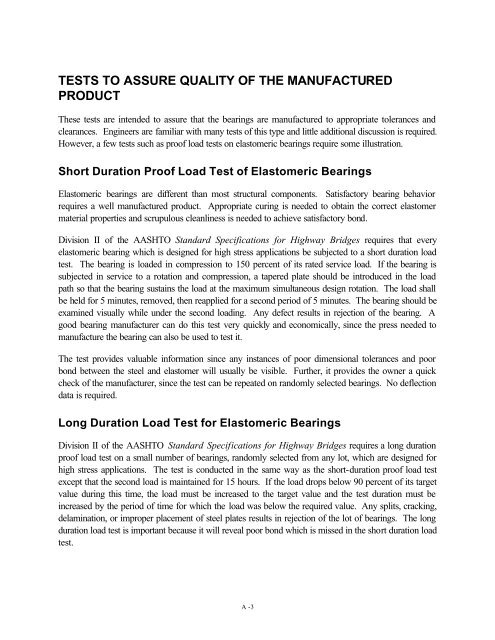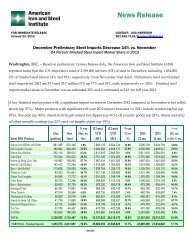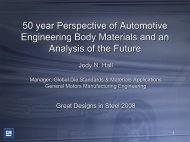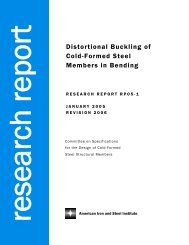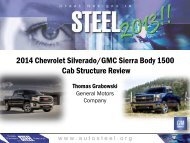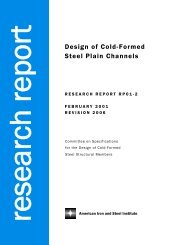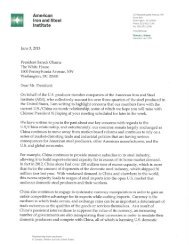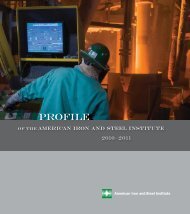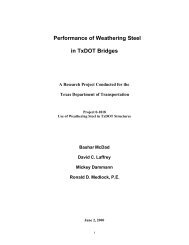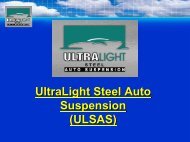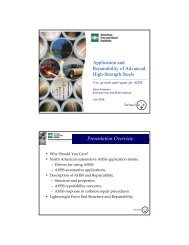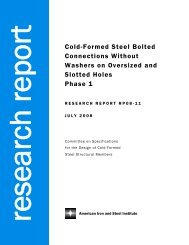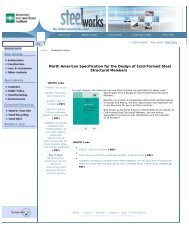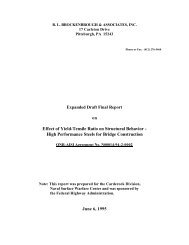Steel Bridge Bearing Selection and Design Guide (Part 3)
Steel Bridge Bearing Selection and Design Guide (Part 3)
Steel Bridge Bearing Selection and Design Guide (Part 3)
You also want an ePaper? Increase the reach of your titles
YUMPU automatically turns print PDFs into web optimized ePapers that Google loves.
TESTS TO ASSURE QUALITY OF THE MANUFACTURED<br />
PRODUCT<br />
These tests are intended to assure that the bearings are manufactured to appropriate tolerances <strong>and</strong><br />
clearances. Engineers are familiar with many tests of this type <strong>and</strong> little additional discussion is required.<br />
However, a few tests such as proof load tests on elastomeric bearings require some illustration.<br />
Short Duration Proof Load Test of Elastomeric <strong>Bearing</strong>s<br />
Elastomeric bearings are different than most structural components. Satisfactory bearing behavior<br />
requires a well manufactured product. Appropriate curing is needed to obtain the correct elastomer<br />
material properties <strong>and</strong> scrupulous cleanliness is needed to achieve satisfactory bond.<br />
Division II of the AASHTO St<strong>and</strong>ard Specifications for Highway <strong>Bridge</strong>s requires that every<br />
elastomeric bearing which is designed for high stress applications be subjected to a short duration load<br />
test. The bearing is loaded in compression to 150 percent of its rated service load. If the bearing is<br />
subjected in service to a rotation <strong>and</strong> compression, a tapered plate should be introduced in the load<br />
path so that the bearing sustains the load at the maximum simultaneous design rotation. The load shall<br />
be held for 5 minutes, removed, then reapplied for a second period of 5 minutes. The bearing should be<br />
examined visually while under the second loading. Any defect results in rejection of the bearing. A<br />
good bearing manufacturer can do this test very quickly <strong>and</strong> economically, since the press needed to<br />
manufacture the bearing can also be used to test it.<br />
The test provides valuable information since any instances of poor dimensional tolerances <strong>and</strong> poor<br />
bond between the steel <strong>and</strong> elastomer will usually be visible. Further, it provides the owner a quick<br />
check of the manufacturer, since the test can be repeated on r<strong>and</strong>omly selected bearings. No deflection<br />
data is required.<br />
Long Duration Load Test for Elastomeric <strong>Bearing</strong>s<br />
Division II of the AASHTO St<strong>and</strong>ard Specifications for Highway <strong>Bridge</strong>s requires a long duration<br />
proof load test on a small number of bearings, r<strong>and</strong>omly selected from any lot, which are designed for<br />
high stress applications. The test is conducted in the same way as the short-duration proof load test<br />
except that the second load is maintained for 15 hours. If the load drops below 90 percent of its target<br />
value during this time, the load must be increased to the target value <strong>and</strong> the test duration must be<br />
increased by the period of time for which the load was below the required value. Any splits, cracking,<br />
delamination, or improper placement of steel plates results in rejection of the lot of bearings. The long<br />
duration load test is important because it will reveal poor bond which is missed in the short duration load<br />
test.<br />
A -3


